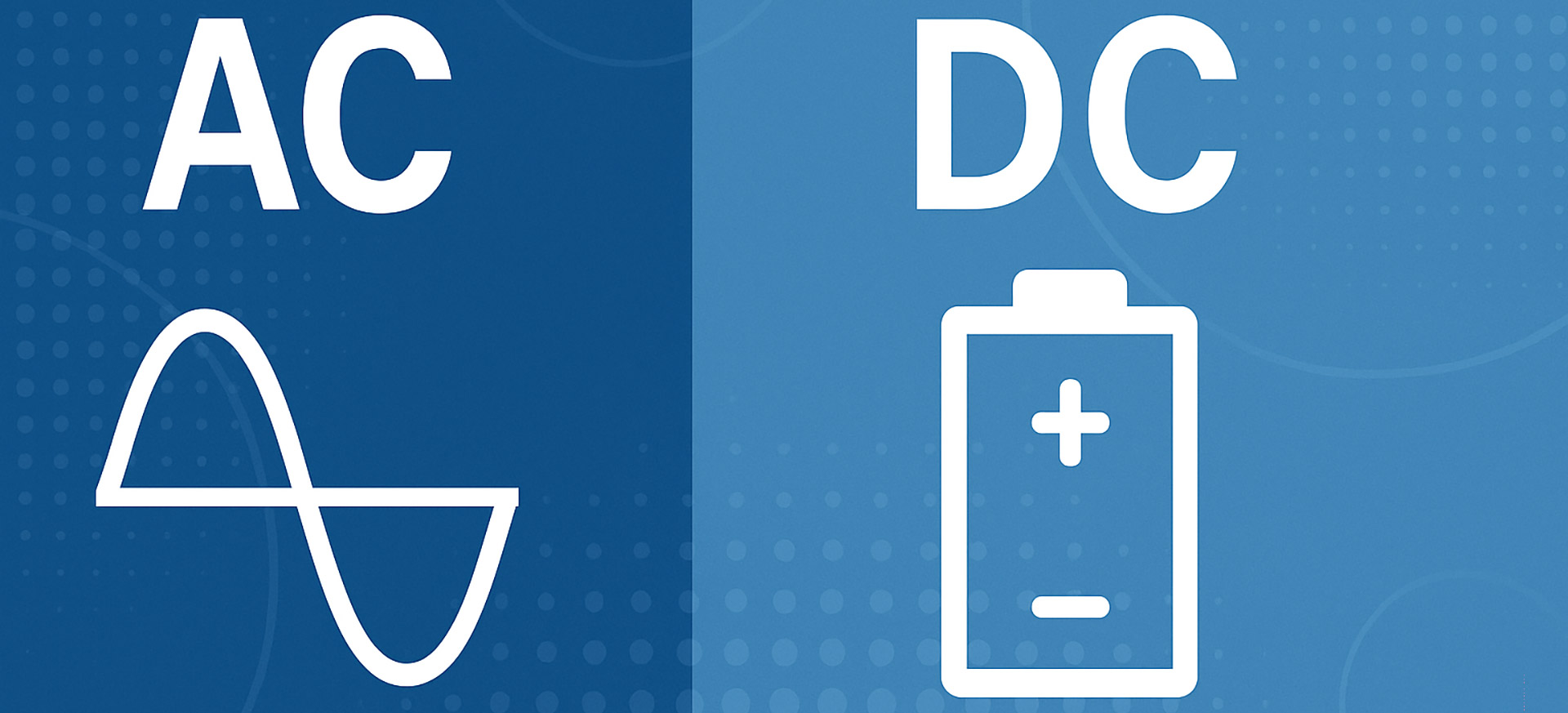
Quick take:
-
AC (Alternating Current) changes direction (and magnitude) many times per second. It’s what comes from wall outlets and powers homes and businesses.
-
DC (Direct Current) flows one way at a constant voltage. It’s what comes from batteries, solar panels, and electronics.
The Basics
What is AC?
AC reverses direction periodically—typically 60 Hz in the U.S. (60 cycles per second) and 50 Hz in many other countries. Because it can be stepped up or down in voltage very efficiently using transformers, AC is ideal for long-distance power transmission and everyday distribution to homes.
What is DC?
DC flows in a single direction and maintains a relatively steady voltage. Batteries, USB chargers, phones, laptops, LED lighting drivers, solar panels, and electric vehicle (EV) battery packs all rely on DC because sensitive electronics prefer stable, one-directional power.
Why We Use Both
-
AC for the grid: It travels long distances with lower losses at high voltages, then transformers bring it down to safe levels for buildings.
-
DC for devices: Most modern electronics internally use DC, so your AC wall power is converted to DC by a power supply/adapter (that little brick on your charger).
-
Bridging the gap:
-
Rectifiers convert AC → DC (e.g., inside phone and laptop chargers, LED drivers).
-
Inverters convert DC → AC (e.g., solar inverters, battery backup systems, and some RV/marine setups).
-
Real-World Examples
-
Your home: Utility delivers AC → your outlets provide AC → devices like TVs/routers convert it to DC.
-
Solar + storage: Panels and batteries produce/store DC → an inverter makes AC for your home and the grid.
-
Electric vehicles: The battery is DC. Home “Level 2” charging uses the car’s onboard rectifier (AC → DC). DC fast charging (public stations) bypasses that and feeds DC directly to the battery for quicker charging.
Pros and Cons at a Glance
AC (Alternating Current)
-
Pros: Easy voltage transformation; efficient long-distance transmission; simple, mature infrastructure.
-
Cons: Not natively compatible with most electronics (must be rectified); frequency can introduce some electrical noise.
DC (Direct Current)
-
Pros: Stable for electronics; battery-friendly; common in solar/storage; enables very efficient LED lighting and computing.
-
Cons: Harder to change voltage efficiently without electronics; long-distance DC systems require specialized converters.
Safety & Efficiency Notes
-
Shock risk: Both AC and DC can be dangerous at high voltages. AC is more likely to cause involuntary muscle contractions at certain frequencies; DC can cause sustained contractions. Always follow code and use qualified electricians.
-
Losses: AC lines can suffer reactive losses; DC systems can have conversion losses in inverters/rectifiers. Good design minimizes both.
-
Harmonics & noise: Switching power supplies (that convert AC↔DC) can introduce electrical noise; quality equipment and proper grounding mitigate it.
Where the Industry Is Headed
-
More DC inside buildings: With solar, batteries, EVs, and LED lighting, DC distribution within certain systems is becoming more common.
-
Smarter conversion: High-efficiency inverters/rectifiers and power factor correction are making mixed AC/DC setups more efficient and grid-friendly.
-
Bidirectional everything: EVs and batteries that can both charge and feed power back (vehicle-to-home/grid) are blurring the lines between AC supply and DC storage.
FAQ
Is household power AC or DC?
AC. Standard outlets provide AC. Many devices immediately convert it to DC internally.
Why not power everything with DC since electronics prefer it?
Grid infrastructure, appliances, and codes are built around AC. Converting entire buildings to DC would be costly; instead, we convert only where needed.
Do solar panels make AC or DC?
DC. An inverter converts it to AC for your home and the grid.
What’s better for EV charging—AC or DC?
Both have roles. AC charging (home) is simpler and gentler. DC fast charging is much quicker for road trips.
Bottom Line
Think of AC as the best way to move power around and DC as the best way to use power inside electronics and batteries. Modern systems combine both with smart converters to deliver safe, efficient energy wherever you need it.

